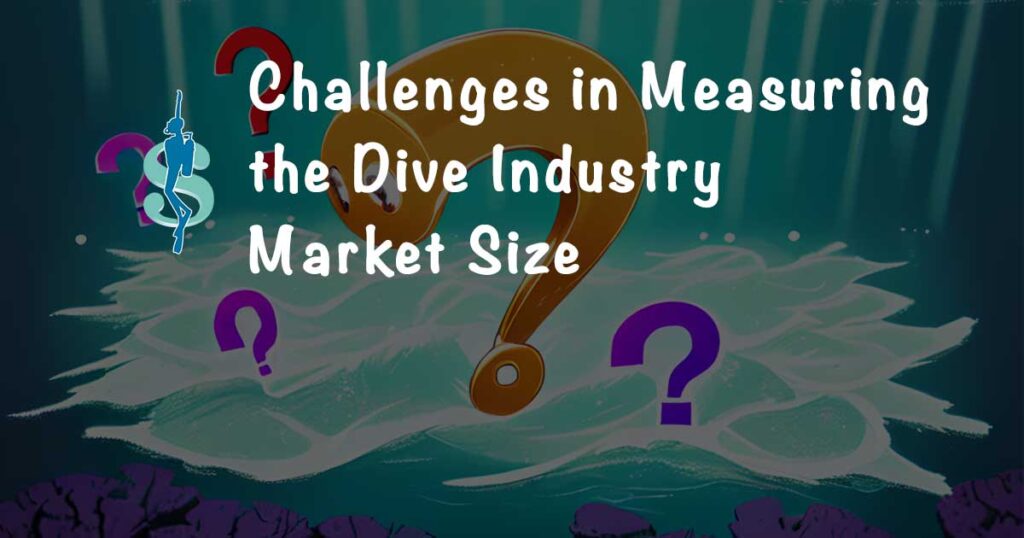Hold on! Before we delve into the challenges of measuring the size of the dive industry, let me pose a question to you.
What Do You Mean by “The Size” of the “Dive Industry”?
Scuba diving is a luxury, and as such, it is about emotions, not transactions. People do not leave their couches at home because they dream of buying dive gear; they seek adventure, a connection with nature, or something similar.
However, to accurately measure the size of the dive industry, we need to examine transactions. As a dive store owner, I couldn’t deposit ‘great emotions’ into my bank account, nor could I use them to pay the staff.
So, what transactional items are we giving to customers in exchange for their cash? It is actually not an easy question to answer.
In most industries, collecting market data is a straightforward process. For instance, the clothing industry comprises manufacturers, distributors, and retailers, all of whom sell a specific type of product: physical goods.
In the dive industry, nothing is forthright. It is one of the most complex industries to analyze because a typical dive center is really a mix of six sectors in one:
- Gear Sales: From manufacturers to consumers via brands, distributors, and retailers.
- Training is a whole different type of business. In our case, it involves a number of small, specialized schools, and on top of that, there is a group of independent instructors who are frequently paid under the table.
- Travel is yet another entirely different industry. And which part of travel are we talking about anyway? The business of being a travel agent is quite different from operating a dive resort for tourists.
- Repair & Maintenance: This part is like managing a garage, and relevant metrics differ from those of a retail store operation.
- Renting Gear is an enterprise like Avis car rental. You own a pile of assets that you try to utilize.
- Fill Station: That one is like a gas station.
So, when you ask about the size of the dive industry, what exactly do you want to know?
For instance, if you include travel in the size of the dive industry, then gear and training will be tiny parts of a multi-billion-dollar travel industry. But if you are a dive gear manufacturer and planning sales targets for next year, that big number would be useless.
Each of these six sectors has a different set of management metrics. Each of these categories of products and services has specific challenges associated with data collection, which we will discuss next.
This post is part of our Dive Industry Compass series by the Business of Diving Institute and Darcy Kieran, author of:
TL;DR Overview
Accurately measuring the scuba diving industry market size is an exceptionally complex challenge, described as a “gigantic 3D puzzle – maybe 6D“. A typical dive center combines six distinct sectors: Gear Sales, Training, Travel, Repair & Maintenance, Renting Gear, and Fill Stations. Since each uses different management metrics, relying on a single number to describe the entire industry is misleading.
When assessing market size, professionals should be cautious of inflated reports, as huge numbers often represent the total GDP impact (including indirect spending, like money spent at local restaurants), rather than the actual revenue generated by core dive businesses. Furthermore, including the multi-billion-dollar travel sector in market calculations can make revenue from gear and training appear insignificant.
The lack of reliable data severely impacts the ability to plan and manage core revenue streams, such as gear sales and training. In Gear Sales, transactional data is obscured because traditional manufacturer surveys miss large retailer in-house brands and because dive shops often mix dive revenue with sales of non-dive items like apparel and surfboards. In the Training Market, metrics are sparse: in the US, DEMA’s quarterly reports only include data from three training agencies. Crucially, certification counts do not provide the market’s dollar value, as training agencies are unaware of the prices charged by instructors and dive centers. Moreover, revenues from independent instructors are often missed, and high-volume, unreported activities like “Discover Scuba Diving” tryouts distort the visibility of overall training activity.
Stakeholders are encouraged to participate in ongoing market surveys to help improve the quality of data available to the industry.
Challenges & Limitations in Measuring the Size of the Dive Industry
Measuring the size of each of the six sectors that comprise the overall dive industry comes with its own unique set of challenges.
Measuring The Size of the Scuba Diving Equipment Market
If you are preparing a business plan for a dive store, you are interested in how much dive gear is sold through dive stores. Typically, it means recreational scuba and snorkeling equipment. However, if you are a dive gear manufacturer, the “size of the market” includes military sales, which for some manufacturers can account for half of their total sales.
In our recently published market analysis of the size of the dive industry, we looked at the recreational scuba diving industry because military and commercial diving are totally different beasts. In the rest of this post, “the dive industry” means the recreational scuba diving industry.
To be clear, though, “recreational diving” includes tech diving, which is an advanced form of recreational diving – something divers do for fun and challenges.
Otherwise, when discussing the dive gear market, we refer to “dive gear manufacturers” because that is how they are commonly referred to in the diving industry’s jargon. However, to understand the sector, you must realize that many of these so-called manufacturers are actually marketing brands. Most wetsuits, for instance, come from a handful of Asian suppliers. None of the “dive gear manufacturers” selling scuba diving wetsuits actually manufactures wetsuits. The same applies to low-end masks, snorkels, and many other dive gear items.
So, what gear should we include when evaluating the size of the dive industry?
Selling snorkeling gear is usually a big part of dive store sales and is definitely a significant component of the sales of dive gear brands. After all, there are about three times more active snorkelers than scuba divers in the world.
But even if we typically assume that snorkeling gear is included in dive gear sales numbers, how could we capture all snorkeling gear sales when evaluating the size of the market?
First of all, should low-end snorkeling gear sold by dive gear brands to large retailers, such as Costco and Walmart, be included in our numbers? Some of that equipment can barely be used for more than fooling around in the backyard pool for half a summer! On the other hand, snorkeling gear sold in dive shops tends to be more high-end equipment. Should all of it still be part of our evaluation of the size of the dive industry? If we survey dive gear manufacturers’ sales of fins, masks, and snorkels, these sales numbers are included.
Besides, how can you be sure if the end-user buying a set of fins is a snorkeler or a scuba diver?
In parallel, big retailers often source gear independently for their in-house brands, as Decathlon does in Europe. Their dive and snorkeling gear sales numbers are usually not part of a survey of dive gear sales conducted with dive gear manufacturers. We shouldn’t underestimate the revenue from snorkeling and diving activities associated with these in-house brands. Let’s not forget that Decathlon brought the highly successful full-face snorkeling mask to market.
A retailer may order its in-house brand BCDs from a known dive gear manufacturer. In that case, if we evaluate the size of the industry by looking at dive gear manufacturers’ revenues, these BCDs are included. However, if the same retailer orders masks directly from a Chinese supplier, these numbers bypass a survey of traditional dive gear manufacturers.
This leads us to another problem – a structural challenge with the way we collect data. Because it is hard to survey manufacturers, dive gear sales are often evaluated by multiplying the number of dive stores in a market by the average sales of a dive shop. However, that leaves a significant portion of the market out, namely sales of dive gear in other retailers, such as West Marine in the USA, and online dive gear retailers that do not operate traditional dive shops.
And even within dive store sales, what should we include or exclude? Spearfishing and freediving gear? Probably yes. A significant portion is sold by dive gear manufacturers and dive stores. But dive stores sell all kinds of other stuff!
For instance, the Business of Diving Institute conducted a study on the average revenues of dive stores. But how much of that top-line is actually from dive gear? And how much is from T-shirts and apparel sales? There is no limit to what dive store owners may decide to sell in their stores. Some dive stores sell surfboards! Therefore, we must dig further to determine which part of it is from the dive gear.
And, wait! That’s not all! What about Apple watches? The Apple Watch Ultra can be used as a scuba diving computer, so if somebody buys one instead of a traditional dive computer, the amount spent on that Apple Watch is squarely in the dive industry. However, most people use an Apple Watch for more than one purpose. Even if we know how many Ultras were sold by Apple, it doesn’t tell us how many were sold to people who intend on using it as a dive computer.
So, measuring the size of the scuba diving industry is a gigantic 3D puzzle – maybe 6D!
Measuring the Size of The Scuba Diving Training & Certification Market
A metric often used to evaluate trends in the dive industry is the number of entry-level open-water certifications.
It used to be reasonably easy to find that kind of information, especially when the dive training agency with the largest market share, PADI, reported its annual number of certifications. However, once PADI no longer experienced high growth rates, they stopped reporting. And since then, their market shares appear to have decreased, so the information may not be as representative as it used to be.
We can get bits and pieces of data on the number of certifications here and there. For instance, in the USA, DEMA produces a quarterly report on the number of entry-level certifications. But only three dive training agencies contribute to the report!
Otherwise, knowing how many new divers obtain an open-water certification does not tell us the size of the dive training market in dollars (or any other currency) because dive centers and instructors make the sales to consumers. Therefore, the training agency issuing the C-card is unaware of the course price.
All of this data pertains to entry-level courses.
Traditionally, the dive industry’s business model has been highly tied to training new divers—selling them entry-level courses and a complete gear set, and sending them on their first dive trip. But that is a dying business model for many reasons that go beyond the scope of this article.
However, regardless of the business model, dive instructors and centers earn revenues from scuba diving training beyond the entry level. For instance, in recent years, we noticed that the tech diving training market was healthier than the entry-level market.
Another way to estimate the scuba diving industry market is to survey dive centers to determine the average level of dive training revenues and then multiply this by the number of dive centers in the market. However, that method misses all revenues generated by independent scuba instructors. Furthermore, dive training agencies have now started bypassing their own “members” by selling directly to consumers. And dive training agencies are famous for being secretive.
Even if dive training agencies were to stop being paranoid and contribute to establishing dive industry metrics that would benefit everybody, including themselves, we would still face the issue of double-counting. It rarely happens at the entry-level but is often seen at more advanced levels of training. For instance, a diver may take a course and get two certification cards for equivalent levels from two different training agencies. If our goal is only to count the number of active divers, then double-counting becomes even more significant. For instance, in the same year, a diver may get an advanced certification from dive training agency A and a rescue diver certification from dive training agency B.
In the past, some dive training organizations have made efforts to use a third-party review to verify data and eliminate double-counting. This was done for the Rebreather Forum, for instance. However, this process requires training agencies to provide databases with a method for identifying individuals. And recent laws on privacy make such endeavors almost impossible to accomplish legally.
Otherwise, should scuba tryouts like “Discover Scuba Diving” be included in the size of the dive industry? We think so. It is squarely part of dive business operations, especially in tourist destinations. However, in many cases, dive operators perform scuba tryouts and discover scuba diving experiences without reporting them to a dive training agency. In fact, the number of unreported scuba tryouts is several times bigger than the official number for reported ones.
Finally, there’s another noteworthy issue with evaluating the size of a regional market because scuba diving is highly tied to travel.
For instance, many Canadian scuba divers have never dived or visited a dive center in Canada. They may have taken their certification course in Bonaire and bought their dive gear in Florida. Tourist destinations like Thailand issue many scuba diving certifications to tourists from around the world—Europeans, North Americans, Chinese, and the list goes on.
The number of active scuba divers in a specific market does not indicate the number of potential clients in that market.
The SFIA provides a reasonably reliable estimate of the number of Americans who are active scuba divers in the USA. However, that survey does not tell us how many of them spend dollars in the USA. And vice versa, maybe scuba divers in the Florida Keys come from outside the USA.
As we said earlier, it’s a giant puzzle!
Measuring the Size of the Dive Travel Market
Here comes another set of challenges!
What should we include in the cost of a dive trip?
Let’s say you are going to the Galapagos for an entire week of intense scuba diving and do not intend to participate in any other activity. In that case, the cost of the whole trip, including airfare and lodging, could be considered an expense directly related to the dive industry.
But what good does it do? Airlines are certainly not something managed by dive industry professionals. Shouldn’t the size of the industry be evaluated on what dive industry professionals manage?
And here is another problem.
There is a trend away from diving-exclusive vacations. Younger generations and casual scuba divers are especially inclined to do some scuba diving, among many other activities. Therefore, if one goes to Costa Rica and only does one day of scuba diving, the cost of airfare and lodging should certainly not be counted as part of the dive industry, since only 14% of the week was dedicated to scuba diving.
Dive Industry Market vs. GDP
This topic is more of a heads-up.
We regularly see reports floating around with huge numbers about the size of the dive industry. However, upon closer examination, the authors were actually estimating the total GDP impact.
An evaluation of the full GDP impact includes all direct and indirect spending linked to scuba diving, such as expenditures in local restaurants and the spending by dive center staff in the local economy. It’s easy to get to a considerable amount that way.
These over-inflated numbers are often produced by organizations lobbying governmental entities. They need to make the dive industry sound as big as possible to increase their chances of being heard. However, these figures are misleading when trying to assess the size of the dive industry itself.
So, How Could We Accurately Measure the Size of the Scuba Diving Industry?
That said, there is a way to accurately measure the size of the scuba diving industry, which we discussed here.
Video Overview & Thoughts
Have a look at more scuba diving market research, surveys, reports & statistics in Your Dive Industry Compass.
If the information in this post was valuable to you, would you consider buying me a coffee?
Either way, please help the dive industry by taking part in ongoing surveys. Results from our past scuba diving market studies are also available here.
Your Dive Industry Compass
Scuba Diving Market Research, Surveys, Reports & Statistics
Shifting Tides
Strategies for Today’s Scuba Divers
Living The Scuba Dream
Plan Your Scuba Instructor Career & Deep Dive the Plan
You may also be interested in The Immersion Zone (our podcast), Scubanomics (our newsletter for dive professionals), and our published books & reference guides.





